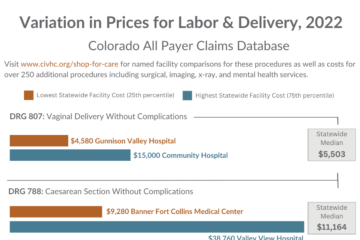Data Dive: Potentially Preventable ED Visits in Colorado
With CIVHC’s Community Dashboard, based on data in the Colorado All Payer Claims Database (CO APCD), users can identify how performance in critical health measures varies across Colorado communities and where the most significant opportunities lie for improvement and impact. Communities, providers, payers, policy makers, and others can examine several aspects of care, including cost, utilization, access to care, and more.
Ideally, all Coloradans will have access to affordable, high-quality care, yet the Community Dashboard shows that people are going to the hospital and Emergency Department (ED) for reasons that could have potentially been prevented.
It is important we acknowledge that there are many reasons people may use the ED over other care settings, ranging from true medical emergencies to challenges accessing timely care in other settings. National and state-level surveys have shown that while some patients use the ED for unavoidable emergencies, others do so because of gaps in primary care access, affordability issues, or uncertainty about where to receive appropriate treatment. Addressing these barriers is key to reducing avoidable ED visits and ensuring patients receive care in the most effective settings.
In this Data Dive, we investigate what the Community Dashboard reveals about potentially preventable visits to the ED, one of the costliest health care settings.
Potentially Preventable ED Visits Dropping Across Rural and Urban Colorado
Overall, the Community Dashboard data shows improvements in preventable ED visits across Colorado. Rates of preventable ED visits among rural Coloradans have historically been higher than for people living in urban areas. However, in more recent years rural and urban rates have been more closely aligned compared to previous years.
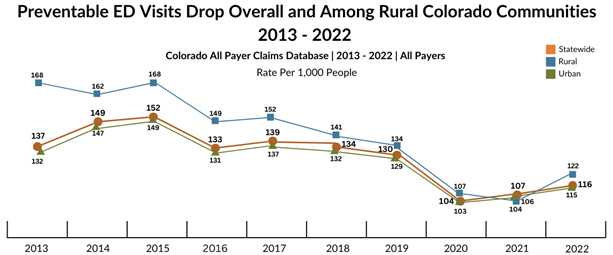
While there is broad improvement across the state, disparities exist by health insurance payer and age groups that clarify opportunities to allocate resources, implement policies, and develop other interventions to reduce utilization of these costly services.
One of the most significant variations in potentially preventable ED visits exists between health insurance payers. People with Medicaid experience significantly higher rates of potentially preventable ED visits compared to people with other coverage types, although rates have come down significantly for the Medicaid covered population since 2013. People covered by Medicare Fee-for-Service (FFS) and Advantage plans have the second highest rates, and people with commercial coverage have the lowest potentially preventable ED visit rates.
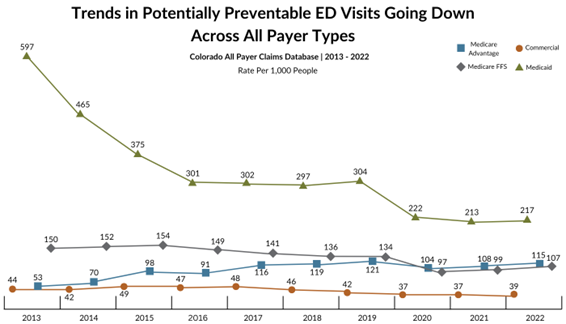
Variation by Age Group
Coloradans aged 18-34, the youngest age group included in the data, have the highest rates of potentially avoidable ED visits, though consistent with geographic and payer trends, rates have improved over time.
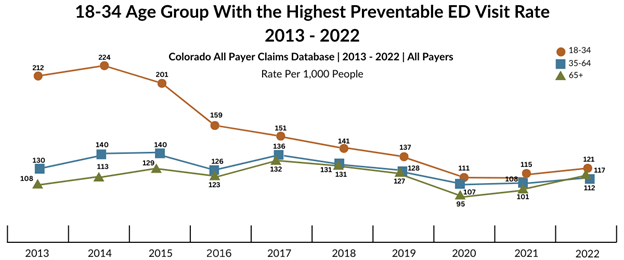
Diving Deeper into Visit Types
The underlying Community Dashboard data is available for download in Excel, and the spreadsheets provide further breakdowns of potentially preventable ED visits into three categories:
- Emergent ED Care Needed but Avoidable: A medical issue that is serious enough for emergency care, but could have been avoided with better access to preventive or primary care. This could include emergency complications from chronic conditions such as diabetes, asthma, or high blood pressure that went untreated.
- Emergent Care Needed but Primary Care Treatable: A medical need that, while emergent, could have been safely treated in a primary care or urgent care setting. Examples include ear infections, upper respiratory conditions, or urinary tract infections.
- Non-Emergent: The medical need was not an emergency.
For further explanation of these categorization groups, visit the Community Dashboard methodology.
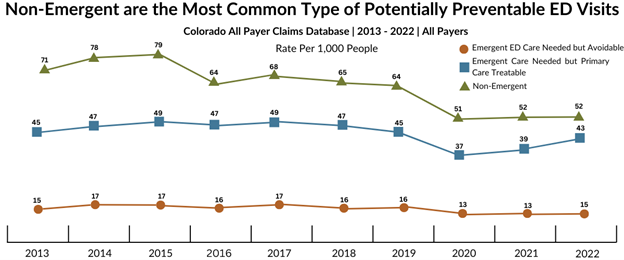
As the chart above shows, non-emergent visits are the most common type of preventable visit, followed by emergent issues that could have been treated by a primary care provider, and emergency care that could have been avoidable. Overall, non-emergent visits have decreased the most significantly over time, while the others have remained generally consistent since 2013.
Trends in these data sets broken down by type of preventable visit mirror the larger trends we have explored in total potentially preventable ED visits. There is a slightly higher rate among rural populations over urban, higher rates among people covered through Medicaid, and higher rates among older people across all visit types. However, rates are gradually lowering across the board.
By further breaking out the types of potentially preventable ED visits occurring across age groups, we can identify which groups and areas across the state that may benefit most from further interventions, such as improved access to primary care, telehealth options, or more health triage support.
For example, older (65+) people living in rural areas have a very high rate of preventable ED visits for conditions that are primary care treatable, although rates have dropped over time.
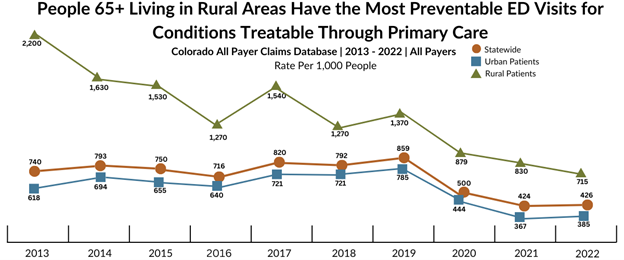
Using these additional data sets, users can see with great detail how particular populations are accessing emergent care and target particular interventions. Users can also marry the preventable ED visits analysis data with CIVHC’s Health Equity Analysis, which shows the correlation between preventable ED visits and social factors like race/ethnicity and income at the census tract level. CIVHC looks forward to continuing to track trends in preventable ED visits as more efforts are made to improve access to affordable, high-quality care for Coloradans.
For more information, visit our Community Dashboard page, or explore additional Data Dives.
